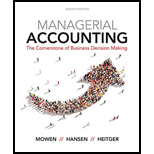
1.
Find out the payback period for the new equipment for each of KD’s projects. Recommend the project to be chosen if rapid payback is important. Also, recommend the project should be chosen.
1.
Explanation of Solution
Payback Period:
The time taken by an investment to recover its original value is known as payback period. It is calculated by dividing the original amount of investment by annual
Calculate payback period for Project A:
| Year |
Unrecovered investment($) (Beginning of year) |
Annual cash Flow($) |
Time needed for payback (Years) |
| 1 | 20,000 | 6,000 | 1.0 |
| 2 | 14,000 | 8,000 | 1.0 |
| 3 | 6,0001 | 10,000 | 0.60 |
| 0 | 2.60 |
Table (1)
Therefore, payback period is 2.60 years.
Calculate payback period for Project B:
| Year |
Unrecovered investment($) (Beginning of year) |
Annual cash Flow($) |
Time needed for payback (Years) |
| 1 | 20,000 | 6,000 | 1.0 |
| 2 | 14,000 | 8,000 | 1.0 |
| 3 | 6,0001 | 10,000 | 0.60 |
| 0 | 2.60 |
Table (2)
Therefore, payback period is 2.60 years.
As both the projects have same payback period, the profitable project must be chosen. The cash flow from project B beyond the payback period is lesser than that of project A. Therefore, project A should be chosen because it is more profitable.
Working Note:
1. Calculation of payback period for third year:
2.
Find out the project to be chosen on the basis of accounting
2.
Explanation of Solution
Accounting Rate of Return:
A method that measures
Use the following formula to calculate accounting rate of return (ARR) for project A:
Substitute $4,8001 for average income and $20,000 for initial investment in the above formula.
Therefore, accounting rate of return is 24%.
Use the following formula to calculate accounting rate of return (ARR) for project A:
Substitute $2,0002 for average income and $20,000 for initial investment in the above formula.
Therefore, accounting rate of return is 10%.
ARR considers the
Working Note:
1. Calculation of average cash inflow:
Calculation of
Calculation of average income:
2. Calculation of average cash inflow:
Calculation of depreciation:
Calculation of average income:
3.
Calculate present value of the annuity to recommend that Person WG should accept the lump sum amount or annuity.
3.
Explanation of Solution
Calculate present value of a future annuity:
Use the following formula to calculate present value of a future annuity;
Substitute $30,000 for annuity value and 11.46992 for discount factor in the above formula.
Therefore, the present value of the annuity is $344,098.
The present value of the future annuity is lesser than the lump sum amount. Therefore, Person WG should accept the lump sum amount.
4.
Find out the
4.
Explanation of Solution
Net Present Value:
The remaining balance of the present value of a project’s inflows and outflows is known as net present value (NPV). It is a discounting model of capital investment decision. A project with a positive NPV increases the wealth of a firm whereas a project with a negative NPV decreases the wealth of a firm.
Use the following formula to calculate NPV of the investment:
Substitute $41,6063 for P and $30,000 for I in the above formula.
Therefore, net present value of the investment is $11,606.
Person D should make the investment because NPV of the investment is positive.
Working Note:
3. Calculation of present value of future cash flow:
5.
Find out the
5.
Explanation of Solution
Internal Rate of Return:
An interest rate at which the present value of an investment’s cash inflows is equal to the present value cost of the investment is known as internal rate of return. The value of NPV is zero in case of an internal rate of return.
Use the following formula to calculate discount factor:
Substitute $400,000 for investment and $75,000 for annual cash flow in the above formula.
Therefore, discount factor for Model CX is 5.33333.
The IRR is approximately 13% which is more than Person PF’s cost of capital. Therefore, Person PF should acquire the equipment.
Want to see more full solutions like this?
Chapter 12 Solutions
Managerial Accounting: The Cornerstone of Business Decision-Making
- I am searching for the correct answer to this general accounting problem with proper accounting rules.arrow_forwardPlease explain the solution to this general accounting problem with accurate explanations.arrow_forwardI need help with this general accounting question using standard accounting techniques.arrow_forward
 Managerial Accounting: The Cornerstone of Busines...AccountingISBN:9781337115773Author:Maryanne M. Mowen, Don R. Hansen, Dan L. HeitgerPublisher:Cengage Learning
Managerial Accounting: The Cornerstone of Busines...AccountingISBN:9781337115773Author:Maryanne M. Mowen, Don R. Hansen, Dan L. HeitgerPublisher:Cengage Learning EBK CONTEMPORARY FINANCIAL MANAGEMENTFinanceISBN:9781337514835Author:MOYERPublisher:CENGAGE LEARNING - CONSIGNMENTPrinciples of Accounting Volume 2AccountingISBN:9781947172609Author:OpenStaxPublisher:OpenStax College
EBK CONTEMPORARY FINANCIAL MANAGEMENTFinanceISBN:9781337514835Author:MOYERPublisher:CENGAGE LEARNING - CONSIGNMENTPrinciples of Accounting Volume 2AccountingISBN:9781947172609Author:OpenStaxPublisher:OpenStax College



